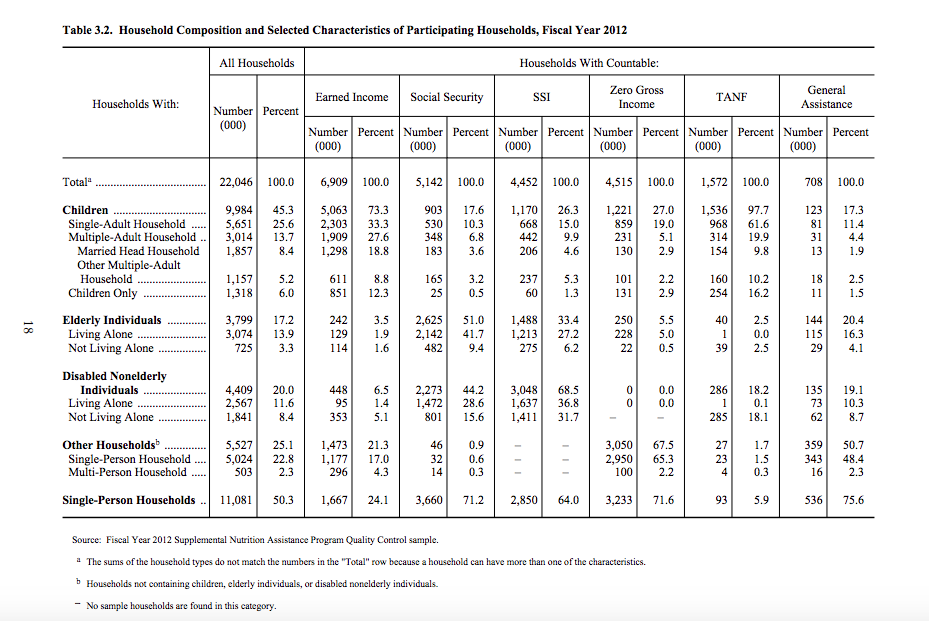Who is Really on Food Stamps?

By:
There are around 46.5 million Americans -- 23 million households -- on food stamps, formally known as Supplemental Nutrition Assistance Program (SNAP) benefits, according to the U.S. Department of Agriculture. These food stamp recipients often serve as the punching bag of political rhetoric and take the brunt of restrictive legislation -- legislation which only serves to limit their benefits and add stigma.
"I don't want to make Black people's lives better by giving them somebody else's money," former Sen. Rick Santorum (R-P.A.) said of welfare recipients in 2012. "I want to give them the opportunity to go out and earn the money."
“If you’re able-bodied, you should be willing to work,” former House Majority Leader Eric Cantor (R-Va.) said about a proposal to cut SNAP back in 2013.
Others claim that SNAP recipients are buying luxury food items with their benefits, which has been the impetus behind two recent restrictive bills in Missouri and Wisconsin.
"I have seen people purchasing filet mignons and crab legs with their EBT cards," Missouri State Rep. Rick Brattin (R) explained to the Washington Post. "When I can't afford it on my pay, I don't want people on the taxpayer's dime to afford those kinds of foods either." Brattin proposed Missouri's law.
But are these common tropes true? Are food stamp recipients the non-working group we hear about? Turns out they're not: SNAP recipients include some of the most vulnerable members of our society.
Who is actually receiving SNAP benefits?
For starters, the majority of food stamp recipients are white. Data from the USDA released in 2013 showed the breakdown of SNAP recipients: 40.2 percent are white, 25.7 percent are Black, 10.3 percent of recipients are Hispanic, 2.1 percent are Asian, and 1.2 percent of SNAP recipients are Native American.
According to a USDA report of the 2012 fiscal year, 82 percent of SNAP recipients were in poverty.
That same report found that nearly 45 percent of food stamp recipients were children under the age of 18, which according to NBC News is around 20 million children. At some point in their lives half of U.S. children will be fed with food stamps. It was also found that nine percent of recipients were elderly (over 60-years-old), and 10 percent were non-elderly disabled adults. (The organization SNAP to Health, puts these figures even higher.)
 USDA Food and Nutrition Services 2012 Report - usda.gov
USDA Food and Nutrition Services 2012 Report - usda.gov
For those adults who are not disabled, without children, and are between the ages of 18-49, SNAP benefits are very restricted. "Nondisabled nonelderly adults living in households without children can receive benefits only if they work or participate in qualifying work-related activities," the USDA explains. "With certain exceptions, those who do not meet these work requirements are restricted to three months of SNAP benefits in any 36-month period."
Also, back in 2012, nearly one-third of households on food stamps (31 percent) had an income, meaning that someone in the family was working, but was still eligible for SNAP. To qualify for SNAP you must be " at or below 130% of the Federal Poverty Level," according to SNAP to Health, and you are only allowed to have up to "$2,250 in countable resources, such as a bank account, or $3,250 in countable resources if at least one person is age 60 or older, or is disabled," according to the USDA.
"At least forty percent of all SNAP beneficiaries live in a household with earnings," SNAP to Health explains. "In fact, the majority of SNAP households do not receive cash welfare benefits (around 10% receive cash welfare), with increasing numbers of SNAP beneficiaries obtaining their primary source of income from employment."
Many who work below the minimum wage utilize government benefits. According to the University of California, Berkeley Labor Center, low wages cost American taxpayers $152.8 billion per year in benefits.
In terms of SNAP recipients eating luxury food like lobster, an article from Huffington Post reports that just 3 percent of survey respondents on SNAP had eaten shellfish during the previous day.
This infographic from Christine Batten of the Community Food & Justice Coalition provides a good breakdown of SNAP:
 Christine Batten of the Community Food & Justice Coalition - cafoodjustice.org
Christine Batten of the Community Food & Justice Coalition - cafoodjustice.org
Who is not on SNAP?
People not receiving SNAP benefits include those who do not qualify for the program -- if you are not in the income bracket, or qualify as disabled or elderly. Applicants can apply at a city or state office, and in most cases you must do an in-person interview. (See the USDA eligibility page for specifics and a guide to see if you qualify). Around 25 percent of people who do qualify for SNAP do not participate in the program.
There is also a misconception that undocumented immigrants are on SNAP. Undocumented immigrants are not eligible for food stamps. Documented immigrants are eligible, however, they are only able to receive SNAP after living in the states for five years.
